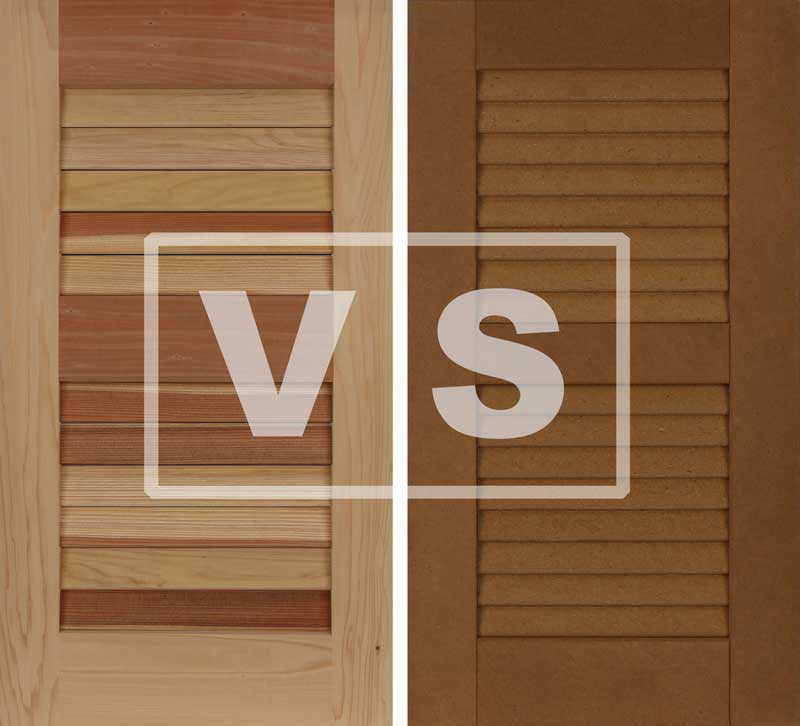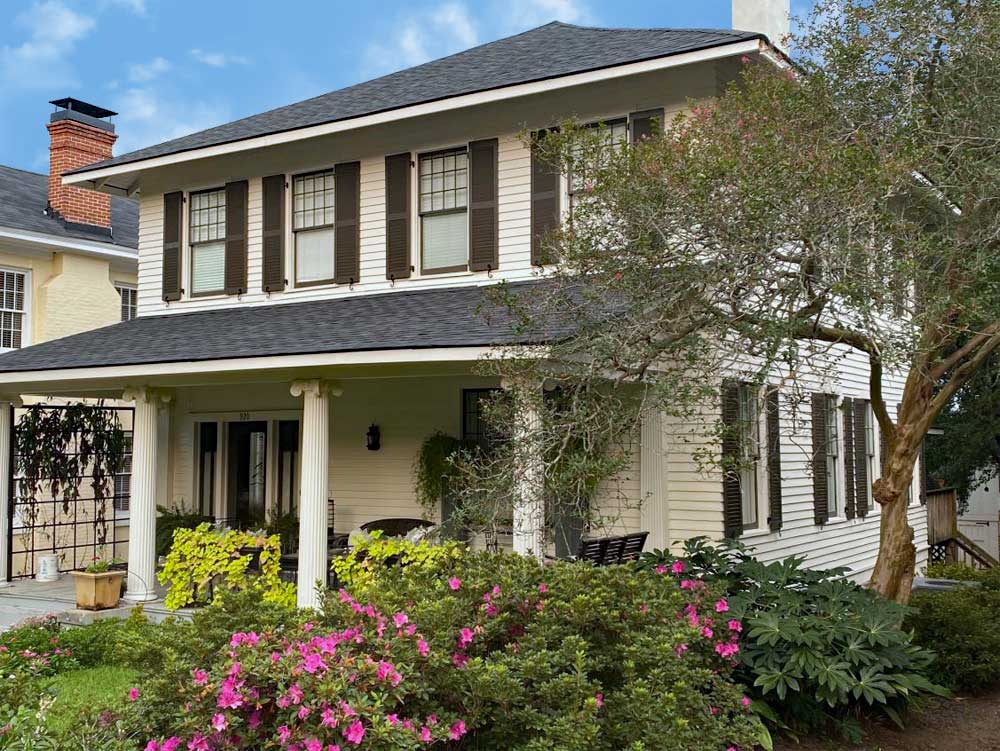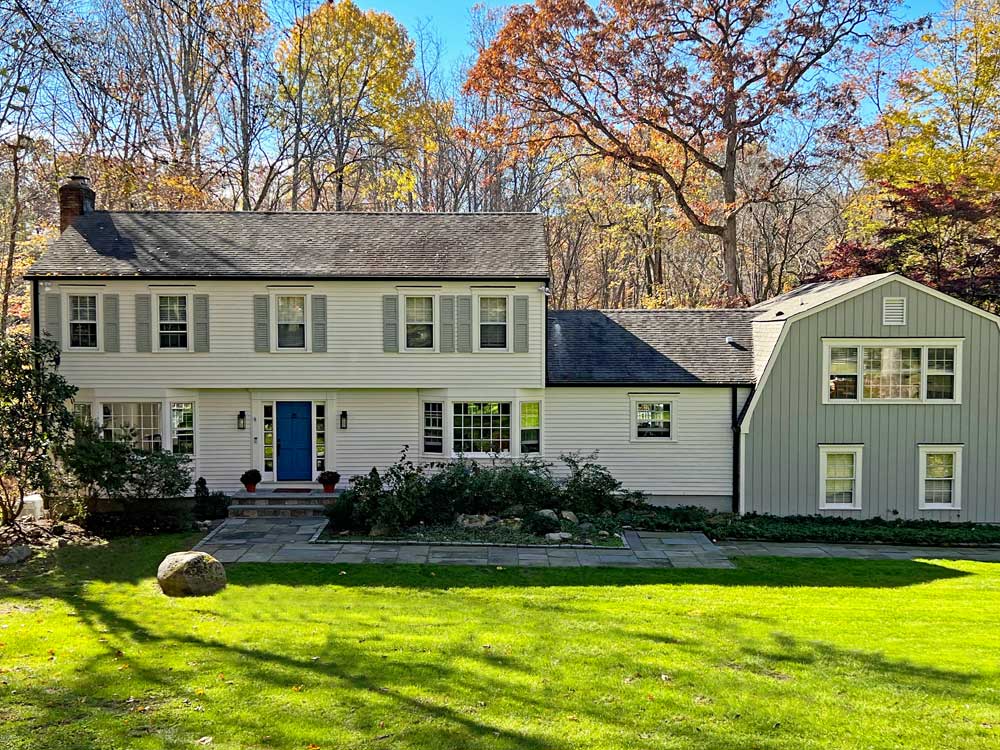Exterior Wood Shutters vs. Composite Shutters
Both exterior wood shutters and composite shutters are of high quality but are often best suited for different applications. The ultimate decision about what outdoor shutter material to use may come down to affordability, durability, historic accuracy, dependability, required maintenance or the ability to match existing shutters.
Authentic Exterior Shutters
Exterior shutters were originally crafted as essential operable components of a functioning house. They opened for light and visibility and closed for a reduction of moving air, light, and sightlines. Primitive shutters in New England and across the country were solid wood. They were installed for a utilitarian purpose with appearance as a fortunate by-product. Historic home renovations necessitate the addition of authentic wood shutters. Unless composite is approved by a governing body regulating restorations, we suggest installing only wood shutters on historic properties.

Premium Wood Shutters
+ Appropriate for historical renovations
+ Great for functional installations
+ Most traditional material for shutters
+ 1.5″ thick stiles and rails
+ Individual louvers & Bahama style available
Composite Shutters
+ Virtually impervious to moisture
+ Realistic appearance
+ Priced less than premium wood
+ Best for stationary installation
+ Installation brackets included
Install Wood or Composite Shutters
Most American homes no longer employ exterior shutters for utilitarian purposes, like light control and privacy, in favor of more convenient and practical resources inside of the home. However, many home designs are enhanced by shutters installed with functional hardware to give a more authentic appearance.
Wood shutters can be installed to be stationary or functional. Installation of wood exterior shutters with strong functional hinges allows them to swing from a position flanking the window to cover the opening. Authentic exterior hardware and shutter dogs can enhance the overall appearance of outdoor shutters.
Composite shutters are automatically shipped with polycarbonate installation brackets for permanently affixing the shutters to the building. This is the recommended installation method for composite shutters, and it is not advised to install composite shutters with functional hardware.
Weight of Composite and Wood Shutters
Composite shutters are manufactured from Extira, a material composed of wood fibers and marine grade resins pressed into large sheets. Components are then milled and assembled into the full shutter. Extira is extremely dense and is therefore heavier than wood. Individual shutter weights can be generated on the product page.
The weight of wood shutters depends on the species. Southern Yellow Pine shutters are the lightest primarily because they are made at 1 inch thick. Premium wood shutters are 1.5 inch thick and are therefore heavier. Mahogany is the most dense causing them to weigh more than others. Red Grandis is second in line followed by Cedar.
Styles of Composite and Wood Shutters
Exterior styles include shutters that incorporate louvers, raised panels, flat panels, shaker panels, boards & battens. Wood and composite shutters can be manufactured in all of these designs, including a combination of styles. Bahama shutters are only available in wood since the shutter design necessitates space between the louvers.

Exterior Shutter Appearance
Composite shutters appear extremely similar to wood shutters for most configurations. There are a few notable differences between the two shutter materials. Composite louvered shutters are milled with banks of interconnected louvers, with no space in between. The louver angle promotes an appearance of realistic louvers, but may not comply with historic society restrictions. Wood louvered shutters do have separation between the louvers.
The front of all composite shutters is crafted with attractive detail. The back side of all composite shutters lacks detail and is not intended for presentation.
Compare Price and Value of Shutter Materials
Economy Pine shutters currently sell at a lower price point. Pine is an entry level wood that while built using all of the best practices has a slightly shorter life expectancy than premium wood. Composite shutters are affordably priced and are a great value for attractive shutters with extended durability. Premium wood shutters have consistently been installed on homes for centuries and are a proven commodity well worth the investment.
Production and Shipping Time
Composite shutters are currently manufactured in about 4-6 weeks. Wood shutters are produced in approximately 4-6 weeks. ShutterLand works diligently to get all shutters built within the quoted period. After shutters are fully finished and boxed, they are shipped direct in about a week or less.
All wood or composite shutters less than 24 inches in width and 86 inches in height ship for free. Get a quick price quote by navigating to the page displaying the desired style and material, and then enter a few specifications.

Lifespan of Outdoor Shutters
Even the best exterior window shutter materials require semi-regular inspection and maintenance. Early identification of paint cracks or chips will prevent moisture from making contact with the raw material. Water that does penetrate the exterior finish can be absorbed and start a deterioration process. All woods will eventually absorb moisture. Those best suited to outdoor environments, like our premium woods, will take it in more slowly than others. Our composite material resists moisture, allowing us to project an extended lifespan.
Paint Finish
Composite and wood shutters can be ordered unfinished, primed or fully painted. The paint used in the finishing stage is the same for both materials for a very similar result. The process begins after a final sanding of the raw shutter. Primer is applied to cover all surfaces. The primer is then sanded and two separate top coats are applied in a satin sheen.
Bahama Shutters
Bahama shutters hinge at the top and swing out from the bottom. When closed they decrease visibility into the building and provide reasonable protection from storms and debris. Open Bahama shutters cast shade to a window in the direct sun and simultaneously allow the occupant to view through the louvers. Composite material does not allow for open louvers and basically defeats the purposed of design intention. Bermuda shutters can only be constructed out of wood.
Why Wood Shutters
Exterior wood shutters are strong, durable and attractive. They have all of the elements for the ultimate shutter installation. In our opinion (and we think about this a lot), wood shutters are best for historic renovations, functional installations and for overall authenticity. It may also be beneficial to compare wood shutters vs vinyl shutters.
Why Composite Shutters
Outdoor composite shutters very effectively mimic the appearance of wood shutters. The biggest benefit of composite shutters is the longevity. With the proper maintenance, a homeowner can expect decades of service from exterior composite shutters. Comparing composite vs vinyl shutters or composite to PVC shutters may also be advantageous.

